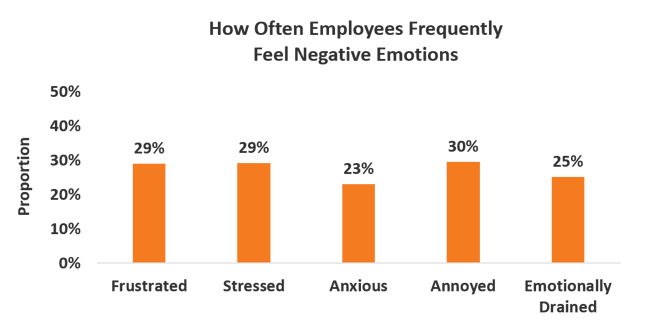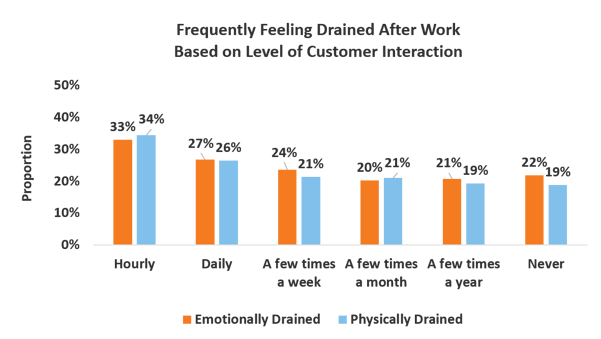
 Despite the popularity of corporate wellness programs, they tend to fall short of expectations and often aren’t very effective. This is because organizations aren't seeing the big picture of employee wellness — they're only focusing on a few aspects of an employee's overall health and well-being.
Despite the popularity of corporate wellness programs, they tend to fall short of expectations and often aren’t very effective. This is because organizations aren't seeing the big picture of employee wellness — they're only focusing on a few aspects of an employee's overall health and well-being.
Wellness programs tend to focus on diet and exercise, but there are many other factors that affect wellness. These include sleep, emotions, customer interactions, and more.
Read on to see what our recent employee wellness research has to say about sleep, stress, emotions, and more!

1. 16% of employees have work situation that negatively impact their sleep on a regular basis.
2. 25% of employees frequently feel physically drained or exhausted after an average day's work.
3. 30% of employees frequently start their work days feeling tired or low on energy.
4. About 20-30% of employees feel frustrated, stressed, anxious, or annoyed daily or a few days a week.
5. 25% of employees frequently feel emotionally drained or exhausted after an average day's work.
6. Employees who interact with customers on an hourly or daily basis are more likely to frequently feel physically and emotionally drained after an average day's work.
One area that has a big impact on employee wellness is sleep. Poor-quality sleep can increase stress and decrease concentration. That combination can take a huge toll on employee wellbeing — and also on engagement and productivity. Insomnia costs companies across the U.S. more than $60 billion annually.
Here are some interesting findings from our research:
Employees need an adequate amount of quality sleep to be productive and feel well. The best way to support employee sleep and energy is to promote a sleep-first, then-work culture.
This means promoting healthy sleep habits and keeping work at work. You should minimize the number of calls, texts, or emails employees must respond to outside of work hours — and encourage them to turn off their notifications after a certain time.
Another important area of employee wellness is an employee’s emotional wellness. Our previous research about emotions in the workplace identified the negative emotions that employees tend to feel most often at work as:
In our wellness research study, we asked employees how often they feel those negative emotions at work.

Here are some surprising statistics that came out of this area of our research:
Negative emotions — especially those shown above — are common and can negatively impact performance and engagement.
Employees who work with customers are more susceptible to stress at work. The graph below shows how often customer-facing employees frequently feel emotionally and physically drained after work.

These results suggest that frequent customer interaction is a driver of employee exhaustion. Customer-facing employees may need additional support to reduce their levels of exhaustion.
There’s more to employee wellness than health fairs and blood pressure. Use these surprising statistics to think outside the typical corporate wellness box. To read more of our research, download our ebook: Stress Management in the Workplace.
Published June 27, 2019 | Written By Dan Harris, Ph.D.